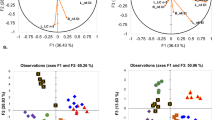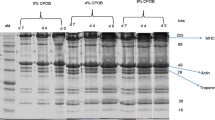Abstract
Lipid oxidation of M. longissimus lumborum in fresh or vacuum packaged (aged) lamb meat stored at 3 °C for 0 or 4 weeks, respectively and displayed under refrigerated conditions for a further 4 days was assessed by measuring the concentration of malondialdehyde (MDA) in meat using the thiobarbituric acid reactive substances procedure. The effects of vitamin E, heme iron and polyunsaturated fatty acids (n-6 and n-3) on lipid oxidation were examined. Results showed a strong positive relationship between heme iron, n-6 and n-3 fatty acids and lipid oxidation when vitamin E was below 2.95 mg/kg muscle. When lipid oxidation was related to vitamin E concentration and the other three variables, respectively, any increase in heme iron or n-6 or n-3 fatty acids concentration did not influence lipid oxidation. Management of diet to elevate muscle vitamin E concentration above 3.45 mg/kg muscle is beneficial to maintain the level of lipid oxidation below 2.4 mg MDA/kg muscle in meat stored for up to 4 weeks. This demonstrates that vitamin E concentration in muscle has a greater influence on controlling lipid oxidation in muscle tissues than do heme iron or polyunsaturated fatty acids.




Similar content being viewed by others
Abbreviations
- MDA:
-
Malondialdehyde
- n-3:
-
Omega-3
- n-6:
-
Omega-6
- PUFA:
-
Polyunsaturated fatty acid(s)
- REML:
-
Restricted maximum likelihood
- TBARS:
-
Thiobarbituric acid reactive substances
References
Ames BM, Shigena MK, Hagen TM (1993) Oxidants, antioxidants and the degenerative diseases of aging. Proc Natl Acad Sci 90:7915–7922
Fang Y, Yang S, Wu G (2002) Free radicals, antioxidants, and nutrition. Nutrition 18:872–879
Bagchi K, Puri S (1998) Free radicals and antioxidants in health and disease. East Mediterr Health J 4:350–360
Frei B (2004) Efficacy of dietary antioxidants to prevent oxidative damage and inhibit chronic disease. J Nutr 134:3196–3198
Dabbagh AJ, Mannion T, Lynch SM, Frei B (1994) The effect of iron overload on rat plasma and liver oxidant status in vitro. Biochem J 300:799–803
Stephens NG, Parsons A, Schofield PM, Kelly F, Sheesman K, Mitchinson MJ, Brown MJ (1996) Randomised controlled trial of vitamin E in patients with coronary disease: Cambridge heart antioxidant study (CHAOS). Lancet 347:781–786
Brigelius-Flohe R, Traber MG (1999) Vitamin E: function and metabolism. FASEB J 13:1145–1155
Bekhit AA, Hopkins DL, Fahri FT, Ponnampalam EN (2013) Oxidative processes in muscle systems and fresh meat: sources, markers, and remedies. Compr Rev Food Sci Food Saf 12:565–597
Morrissey PA, Sheehy PJ, Galvin K, Kerry JP, Buckley DJ (1998) Lipid stability in meat and meat products. Meat Sci 49:73–86
Chaijan M (2008) Review: lipid and myoglobin oxidations in muscle foods. Songklanakarin J Sci Technol 30:47–53
Henning B, Toborek M, McClain CJ (2001) High energy diets, fatty acids and endothelial cell function: implications for atherosclerosis. J Am College Nutr 20:97–105
Allen KE, Cornforth DP (2006) Myoglobin oxidation in a model system as affected by nonheme iron and iron chelating agents. J Agric Food Chem 54:10134–10140
Nijveldt RJ, van Nood E, van Hoorn DEC, Boelens PG, van Norren K, van Leeuwen PAM (2001) Flavonoids: a review of probable mechanisms of action and potential applications. Am J Clin Nutr 74:418–425
Warner RD, Dunshea FR, Ponnampalam EN, Cottrell JJ (2005) Effects of nitric oxide and oxidation in vivo and post-mortem on meat tenderness. Meat Sci 71:205–217
Jensen C, Lauridsen C, Bertelsen G (1998) Dietary vitamin E: quality and storage stability of pork and poultry. Trends Food Sci Technol 9:62–72
Faustman C, Sun Q, Mancini R, Suman S (2010) Myoglobin and lipid oxidation interactions: mechanistic bases and control. Meat Sci 86:86–94
Ponnampalam EN, Butler KL, McDonagh MB, Jacobs JL, Hopkins DL (2012) Relationship between muscle antioxidant status, forms of iron, polyunsaturated fatty acids and functionality (retail colour) of meat in lambs. Meat Sci 90:297–303
Burnett VF, Seymour GR, Norng S, Jacobs JL, Ponnampalam EN (2012) Lamb growth performance and carcass weight from rotationally grazed perennial pasture systems compared with annual pasture systems with supplements. Anim Prod Sci 52:248–254
Ball GFM (1988) Analytical considerations. In Ball GFM (Ed), Fat-soluble vitamin assays in food analysis: a comprehensive review, pp 105 Elsevier
Rhee KS, Ziprin YA (1987) Modification of the Schricker nonheme iron method to minimize pigment effects for red meats. J Food Sci 52:1174–1176
O’Fallon JV, Busboom JR, Nelson ML, Gaskins CT (2007) A direct method for fatty acid methyl ester synthesis: application to wet meat tissues, oils, and feedstuffs. J Animal Sci 85:1511–1521
Ponnampalam EN, Burnett VF, Norng S, Warner RD, Jacobs JL (2012) Vitamin E and fatty acid content of lamb meat from perennial or annual pasture systems with supplements. Anim Prod Sci 52:255–262
Witte VC, Krause GF, Bailey ME (1970) A new extraction method for determining 2-thiobarbituric acid values of pork and beef during storage. J Food Sci 35:582–585
Khliji S, van de Ven R, Lamb TA, Lanza M, Hopkins DL (2010) Relationship between consumer ranking of lamb colour and objective measures of colour. Meat Sci 85:224–229
Magee L (1990) R2 measures based on Wald and likelihood ratio joint significance tests. Am Stat 44:250–253
Sarkar D (2008) Lattice: multivariate data visualization with R. Springer, New York. ISBN 978-0-387-75968-5
Lombardi-Boccia G, Martinez-Dominguez B, Aguzzi A (2002) Total heme and non-heme iron in raw and cooked meats. Food Chem Toxicol 67:1738–1741
Lykkesfeldt J, Svendsen O (2007) Oxidants and antioxidants in disease: oxidative stress in farm animals. Vet J 173:502–511
Halliwell B (2000) Lipid peroxidation, antioxidants and cardiovascular disease: how should we move forward? Cardiovasc Res 47:410–418
Almela E, Jordan MJ, Martinez C, Sotomayor JA, Bedia M, Banon S (2010) Ewe’s diet (pasture vs grain-based feed) affects volatile profile of cooked meat from light lamb. J Agric Food Chem 58:9641–9646
Díaz MT, Cañeque V, Sánchez CI, Lauzurica S, Pérez C, Fernández C, Álvarez I, Fuente JD (2011) Nutritional and sensory aspects of light lamb meat enriched in n-3 fatty acids during refrigerated storage. Food Chem 124:147–155
Jiang T, Busboom JR, Nelson ML, Mengarelli R (2011) Omega-3 fatty acids affected human perception of ground beef negatively. Meat Sci 89:390–399
Rhee KS, Anderson LM, Sams AR (1996) Lipid oxidation potential of beef, chicken, and pork. J Food Sci 61:8–12
Baron CP, Andersen HJ (2002) Myoglobin-induced lipid oxidation: a review. J Agric Food Chem 50:3887–3897
Ponnampalam EN, Sinclair AJ, Egan AR, Ferrier G, Leury BJ (2002) Dietary manipulation of muscle long-chain omega-3 and omega-6 fatty acids and sensory properties of lamb meat. Meat Sci 60:125–132
Ponnampalam EN, Trout GR, Sinclair AJ, Egan AR, Leury BJ (2001) Comparison of the color stability and lipid oxidative stability of fresh and vacuum packaged lamb muscle containing elevated omega-3 and omega-6 fatty acid levels from dietary manipulation. Meat Sci 58:151–161
Ponnampalam EN, Butler KL, Hopkins DL, Kerr MG, Dunshea FR, Warner RD (2008) Genotype and age effects on sheep meat production. 5. Lean meat and fat content in the carcasses of Australian sheep genotypes at 20-, 30- and 40-kg carcass weights. Aust J Exp Agric 48:893–897
Greene BE, Cumuze TH (1981) Relationship between TBA numbers and inexperienced panellists assessments of oxidized flavour in cooked beef. J Food Sci 47:52–54
Verma SP, Sahoo J (2000) Extension of shelf life of ground chevon during refrigerated storage by using ascorbic acid. J Food Sci Technol 37:565–570
Berruga MI, Vergara H, Gallego L (2005) Influence of packaging conditions on microbial and lipid oxidation in lamb meat. Small Rumin Res 57:257–264
Campo MM, Nute GR, Hughes SI, Enser M, Wood JD, Richardson RI (2006) Flavour perception of oxidation in beef. Meat Sci 72:303–311
Acknowledgments
The funding for this work was provided by the Department of Primary Industries, Victoria, Australia (Project—Novel High Value Lamb). We would like to thank Greg Seymour for field management of lambs, and Matthew Kerr, Athula Natharampatta and Wayne Brown for organising the slaughter of lambs, muscle sample collection, retail display of the meat for lipid oxidation assessment, and fatty acid determination of meat. The assistance provided by Tim Plozza and George Croatto for muscle vitamin E and iron components analysis is appreciated.
Author information
Authors and Affiliations
Corresponding author
About this article
Cite this article
Ponnampalam, E.N., Norng, S., Burnett, V.F. et al. The Synergism of Biochemical Components Controlling Lipid Oxidation in Lamb Muscle. Lipids 49, 757–766 (2014). https://doi.org/10.1007/s11745-014-3916-5
Received:
Accepted:
Published:
Issue Date:
DOI: https://doi.org/10.1007/s11745-014-3916-5




